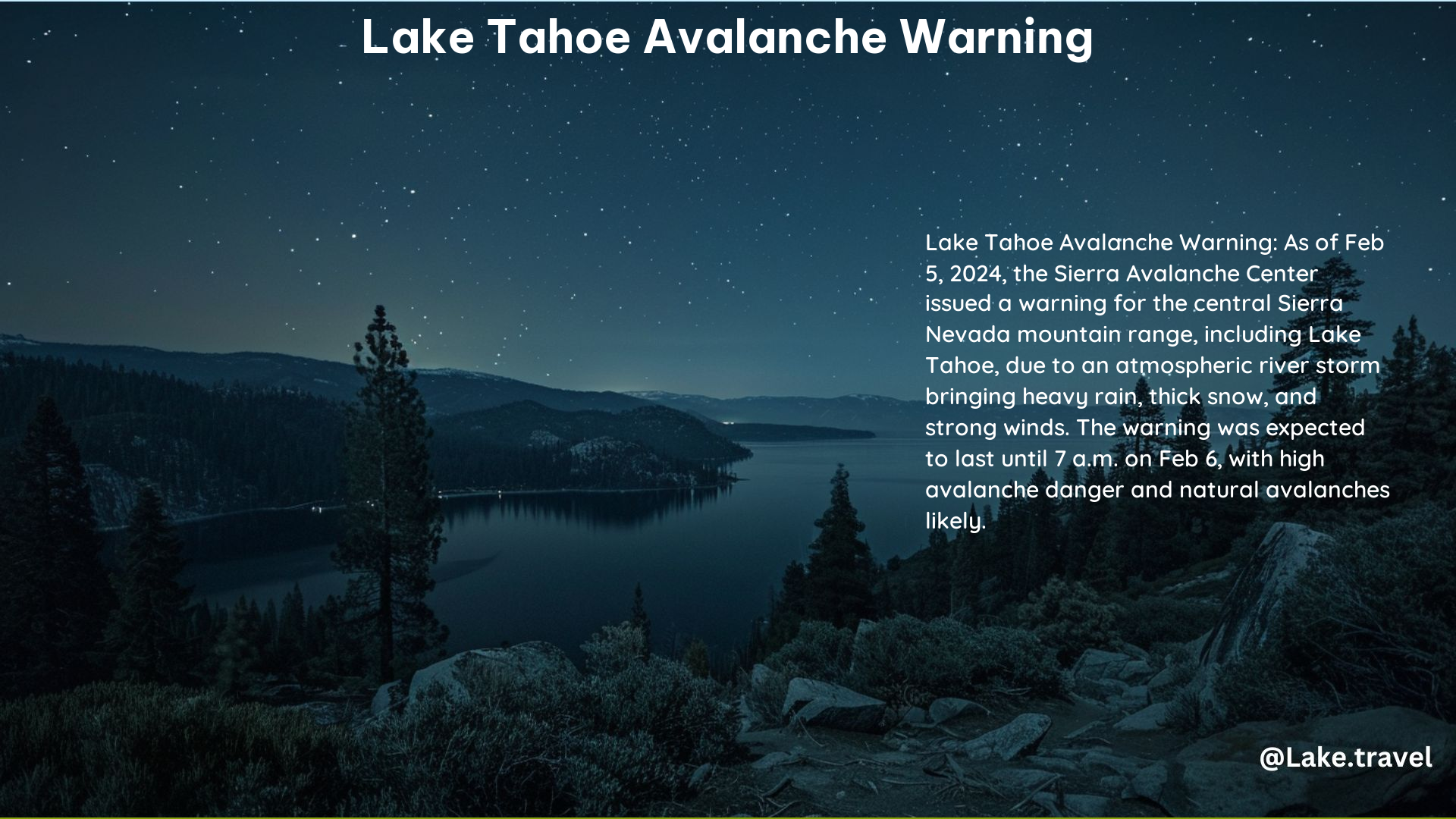Current Avalanche Warning Status
The current avalanche warning status in the central Sierra Nevada mountain range, including Lake Tahoe, is not active. The last avalanche forecast for the 2023-2024 season was posted on April 21st, and no new warnings have been issued since then.
Duration and Coverage of Avalanche Warning

The previous avalanche warning issued on February 5, 2024, was expected to last until 7 a.m. on Tuesday, February 6, 2024. This warning covered the central Sierra Nevada mountain range between Yuba Pass on Highway 49 in the north and Ebbetts Pass on Highway 4 in the south, including Lake Tahoe. However, it did not include ski areas and highways where avalanche mitigation programs exist.
Avalanche Danger in Sierra Nevada
Avalanche danger in the Sierra Nevada region can be high due to heavy snowfall and strong winds. During periods of high danger, natural avalanches are likely, and human-triggered avalanches are very likely. Travel in, near, or below avalanche terrain is not recommended during such periods. Skiers are advised to use extra caution and stick to mellow slopes or dense trees that are free of overhead hazards.
Factors Affecting Avalanche Risk in Lake Tahoe
The Lake Tahoe region is susceptible to avalanche activity due to several factors:
-
Snowpack Conditions: The Sierra Nevada mountains receive significant snowfall during the winter months, leading to a deep and unstable snowpack. Rapid changes in temperature, precipitation, and wind can create weak layers within the snowpack, increasing the risk of avalanche.
-
Terrain: The rugged and steep terrain around Lake Tahoe, including the numerous mountain peaks and slopes, provides an ideal environment for avalanche formation and release.
-
Weather Patterns: The Lake Tahoe area is influenced by a variety of weather patterns, including Pacific storms, cold fronts, and high-pressure systems. These weather events can bring heavy snowfall, strong winds, and rapid temperature changes, all of which contribute to avalanche risk.
-
Human Activity: Recreational activities, such as skiing, snowmobiling, and backcountry exploration, can increase the risk of human-triggered avalanches if proper precautions are not taken.
Avalanche Forecasting and Monitoring
The Sierra Avalanche Center and the Eastern Sierra Avalanche Center are the primary organizations responsible for monitoring and forecasting avalanche conditions in the Lake Tahoe region. These centers use a variety of data sources, including weather observations, snowpack analysis, and field observations, to assess the current and future avalanche danger.
The avalanche forecasts provided by these centers include information on the avalanche danger level, the likelihood of natural and human-triggered avalanches, and the expected size and distribution of avalanches. This information is crucial for backcountry users, ski resorts, and transportation agencies to make informed decisions about their activities and operations.
Avalanche Safety Recommendations
To stay safe in the Lake Tahoe backcountry during periods of high avalanche danger, it is essential to follow these safety recommendations:
-
Check the Avalanche Forecast: Always check the latest avalanche forecast from the Sierra Avalanche Center or the Eastern Sierra Avalanche Center before venturing into the backcountry.
-
Carry Proper Gear: Equip yourself with essential avalanche safety gear, including a beacon, shovel, and probe, and ensure that you know how to use them effectively.
-
Travel in Small Groups: Avoid traveling alone and instead, move in small, experienced groups that can assist each other in the event of an avalanche.
-
Stick to Safer Terrain: Avoid steep, open slopes and terrain traps, and instead, choose mellow slopes, dense trees, and areas with a lower avalanche risk.
-
Continuously Assess the Conditions: Be vigilant and continuously assess the snowpack, weather, and terrain conditions throughout your backcountry excursion.
-
Obtain Avalanche Education: Consider taking an avalanche safety course to learn the necessary skills and knowledge to navigate the backcountry safely during periods of high avalanche danger.
By following these safety recommendations and staying informed about the current avalanche conditions, you can enjoy the beauty of the Lake Tahoe backcountry while minimizing the risks associated with avalanche activity.
Additional Resources
- Sierra Avalanche Center: Provides forecasts, observations, and weather information for the Lake Tahoe area.
- Eastern Sierra Avalanche Center: Issues backcountry avalanche warnings for areas of Inyo and Mono counties.
- National Weather Service: Offers avalanche advisories and weather forecasts for the Lake Tahoe area.
References
- https://www.sierraavalanchecenter.org/forecasts
- https://www.esavalanche.org/forecasts/
- https://www.sierraavalanchecenter.org
- https://www.sacbee.com/news/local/article285095187.html
- https://www.weather.gov/rev/avalanche
